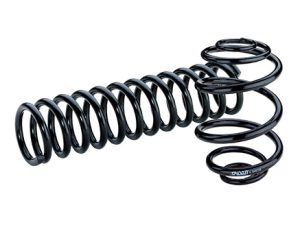Table of Contents
- What Are Suspension Springs?
- Signs of Worn or Damaged Springs
- How to Inspect Suspension Springs
- Maintenance Tips for Suspension Springs
- Signs of Worn or Damaged Springs and Recommended Actions
- When to Replace Suspension Springs
- The Importance of Timely Spring Replacement
The suspension system of a vehicle is pivotal to its safety, performance, and comfort. Among the key components of this system are the springs, which bear the vehicle’s weight, absorb road shocks, and maintain proper alignment. Over time, springs can wear out or become damaged, compromising the vehicle’s safety and drivability. Identifying the signs of worn or damaged springs early is crucial to prevent further issues. This article will guide you through recognizing these signs and understanding how to address them.
What Are Suspension Springs?

Suspension springs are an essential part of a car’s suspension system. They work in conjunction with shock absorbers and struts to absorb road impacts and maintain the vehicle’s height and alignment. Common types of suspension springs include:
- Coil Springs: Found in most modern vehicles, these are helical-shaped and compress under weight.
- Leaf Springs: Typically used in trucks and older vehicles, these are flat, elongated, and layered.
- Torsion Bars: These rely on twisting motion to provide suspension and are commonly found in some trucks and SUVs.
Signs of Worn or Damaged Springs
Detecting worn or damaged springs early can save you from costly repairs and ensure a safe driving experience. Here are some common indicators:
1. Sagging or Uneven Vehicle Height
- Symptom: One side of the vehicle sits lower than the other when parked on a level surface.
- Cause: A weakened or broken spring fails to maintain the vehicle’s height evenly.
- Action: Inspect the springs visually or measure the vehicle’s height from the ground to confirm.
2. Excessive Bouncing
- Symptom: The vehicle continues to bounce after hitting a bump or pothole.
- Cause: Springs lose their ability to absorb shocks effectively.
- Action: Perform a bounce test by pressing down on the car’s corner and observing how quickly it stabilizes.
3. Noises from the Suspension
- Symptom: Clunking, creaking, or squeaking noises when driving over rough terrain.
- Cause: Damaged or misaligned springs can rub against other components.
- Action: Inspect for visible damage or loose connections in the suspension system.
4. Poor Handling and Stability
- Symptom: The car leans excessively during turns or feels unstable at high speeds.
- Cause: Worn springs fail to maintain proper alignment and balance.
- Action: Check for misalignment or inspect the springs for wear.
5. Uneven Tire Wear
- Symptom: Tires exhibit irregular wear patterns.
- Cause: A sagging suspension system can cause uneven weight distribution.
- Action: Combine tire inspection with a suspension system evaluation.
6. Visible Damage or Rust
- Symptom: Springs appear cracked, broken, or heavily corroded.
- Cause: Wear and tear or exposure to harsh environmental conditions.
- Action: Replace springs immediately if damage is evident.
How to Inspect Suspension Springs

Regular inspections can help identify issues before they escalate. Here are steps for inspecting your suspension springs:
Visual Inspection
- Look for cracks, breaks, or rust on the springs.
- Check for uneven spring compression.
- Inspect the spring mounts and surrounding components.
Functional Tests
- Bounce Test: Push down on each corner of the vehicle and release. Excessive bouncing indicates weak springs.
- Driving Test: Pay attention to handling, especially when cornering or driving over bumps.
Using Diagnostic Tools
- Use a suspension tester to evaluate performance.
- Have a professional use diagnostic equipment for a detailed analysis.
Maintenance Tips for Suspension Springs
Prolong the life of your suspension springs with proper maintenance:
- Regular Inspections: Check the suspension system during routine vehicle servicing.
- Avoid Overloading: Excessive weight can strain the springs and lead to premature wear.
- Keep Springs Clean: Remove dirt, debris, and road salt to prevent rust.
- Replace in Pairs: Always replace springs on both sides of an axle to maintain balance and stability.
- Follow Manufacturer’s Guidelines: Adhere to recommended maintenance schedules and weight limits.
Signs of Worn or Damaged Springs and Recommended Actions
| Symptom | Likely Cause | Recommended Action |
|---|---|---|
| Sagging vehicle height | Broken or weakened springs | Replace springs |
| Excessive bouncing | Worn springs or shocks | Perform bounce test; replace as needed |
| Noises from suspension | Misalignment or damage | Inspect and repair/replace components |
| Poor handling | Weak or damaged springs | Inspect suspension; replace springs |
| Uneven tire wear | Sagging suspension | Align suspension; replace springs |
| Visible rust/damage | Environmental wear and tear | Replace springs |
When to Replace Suspension Springs
Springs typically last 80,000 to 120,000 kilometers, but this varies based on driving conditions and vehicle type. Replace them if:
- The vehicle displays multiple symptoms of worn springs.
- Visual inspection reveals damage or excessive rust.
- Manufacturer’s replacement interval has been reached.
For reliable and durable replacement springs, Order suspension springs online from Elart’s comprehensive store.
The Importance of Timely Spring Replacement
Delaying the replacement of worn or damaged springs can lead to:
- Increased wear on other suspension components.
- Reduced vehicle stability and safety.
- Higher repair costs due to additional damage.
By identifying the signs of worn springs early, you can maintain your vehicle’s safety and performance while avoiding costly repairs.
Conclusion
Recognizing the signs of worn or damaged suspension springs is vital for ensuring a safe and comfortable driving experience. Regular inspections, timely maintenance, and prompt replacements can prevent costly issues and enhance your vehicle’s longevity. For high-quality suspension springs and components, visit Elart’s store and Order suspension springs online today. Keep your vehicle in top condition and enjoy the benefits of a well-maintained suspension system.